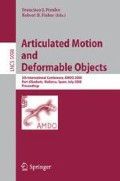Abstract
This paper addresses the problem of real-time location of the joints or centres of rotation (CoR) of human skeletons in the presence of missing data. The data is assumed to be 3d marker positions from a motion capture system. We present an integrated framework which predicts the occluded marker positions using a Kalman filter in combination with inferred information from neighbouring markers and thereby maintains a continuous data-flow. The CoR positions can be calculated with high accuracy even in cases where markers are occluded for a long period of time.
Access this chapter
Tax calculation will be finalised at checkout
Purchases are for personal use only
Preview
Unable to display preview. Download preview PDF.
References
Hashiguchi, J., Nivomiya, H., Tanaka, H., Nakamura, M., Nobuhara, K.: Biomechanical analysis of a golf swing using motion capture system. In: Proc. of the Japanese Society for Orthopaedic Biomechanics, vol. 27, pp. 325–330 (2006)
Broeren, J., Sunnerhagen, K.S., Rydmark, M.: A kinematic analysis of a haptic handheld stylus in a virtual environment: a study in healthy subjects. Journal of NeuroEngineering and Rehabilitation 4,13 (2007)
Menache, A.: Understanding Motion Capture for Computer Animation and Video Games. Morgan Kaufmann Publishers Inc, USA (1999)
Cameron, J., Lasenby, J.: A real-time sequential algorithm for human joint localization. In: ACM SIGGRAPH Posters, USA, p. 107 (2005)
Gamage, S., Lasenby, J.: New least squares solutions for estimating the average centre of rotation and the axis of rotation. J. of Biomechanics 35(1), 87–93 (2002)
Kirk, A.G., O’Brien, J.F., Forsyth, D.A.: Skeletal parameter estimation from optical motion capture data. In: Proc. of the IEEE CVPR, pp. 782–788 (2005)
O’Brien, J.F., Bodenheimer, R.E., Brostow, G.J., Hodgins, J.K.: Automatic joint parameter estimation from magnetic motion capture data. In: Proceedings of Graphic Interface, pp. 53–60 (2000)
Ehrig, R.M., Taylor, W.R., Duda, G.N., Heller, M.O.: A survey of formal methods for determining the centre of rotation of ball joints. Journal of Biomechanics 39(15), 2798–2809 (2006)
Wiley, D.J., Hahn, J.K.: Interpolation synthesis of articulated figure motion. IEEE Comp. Graphics and Applications 17(6), 39–45 (1997)
Rose, C., Cohen, M., Bodenheimer, B.: Verbs and adverbs: Multidimensional motion interpolation. IEEE Comp. Graphics and Applications 18(5), 32–40 (1998)
Nebel, J.: Keyframe interpolation with self-collision avoidance. In: Proc. of the Workshop on Comp. Animation and Simulation, pp. 77–86. Springer, Heidelberg (2006)
Van Rhijn, A., Mulder, J.D.: Optical tracking and automatic model estimation of composite interaction devices. In: IEEE VR Conference, pp. 135–142 (2006)
Dorfmüller-Ulhaas, K.: Robust optical user motion tracking using a kalman filter. Technical Report TR-2003-6, Institut fuer Informatik 2, 86159 Augsburg (2003)
Welch, G., Bishop, G., Vicci, L., Brumback, S., Keller, K., Colucci, D.: The HiBall tracker: High-performance wide-area tracking for virtual and augmented environments. In: VRST, December 20-22, 1999, pp. 1–10. ACM, New York (1999)
Herda, L., Fua, P., Plänkers, R., Boulic, R., Thalmann, D.: Using skeleton-based tracking to increase the reliability of optical motion capture. Human Movement Science Journal 20(3), 313–341 (2001)
Hornung, A., Sar-Dessai, S.: Self-calibrating optical motion tracking for articulated bodies. In: Proceedings of the IEEE Conference on VR, Washington, DC, USA, pp. 75–82 (2005)
Liu, G., McMillan, L.: Estimation of missing markers in human motion capture. The Visual Computer 22(9-11), 721–728 (2006)
Aristidou, A., Cameron, J., Lasenby, J.: Real-time estimation of missing markers in human motion capture. In: Proceedings of the iCBBE 2008 (2008)
Horn, B.: Closed-form solution of absolute orientation using unit quaternions. Journal of the Opt. Society of America 4, 629–642 (1987)
Kalman, R.E.: A new approach to linear filtering and prediction problems. Journal of Basic Engineering, 35–45 (1960)
PhaseSpace Inc.: Optical motion capture systems, http://www.phasespace.com
Author information
Authors and Affiliations
Editor information
Rights and permissions
Copyright information
© 2008 Springer-Verlag Berlin Heidelberg
About this paper
Cite this paper
Aristidou, A., Cameron, J., Lasenby, J. (2008). Predicting Missing Markers to Drive Real-Time Centre of Rotation Estimation. In: Perales, F.J., Fisher, R.B. (eds) Articulated Motion and Deformable Objects. AMDO 2008. Lecture Notes in Computer Science, vol 5098. Springer, Berlin, Heidelberg. https://doi.org/10.1007/978-3-540-70517-8_23
Download citation
DOI: https://doi.org/10.1007/978-3-540-70517-8_23
Publisher Name: Springer, Berlin, Heidelberg
Print ISBN: 978-3-540-70516-1
Online ISBN: 978-3-540-70517-8
eBook Packages: Computer ScienceComputer Science (R0)

